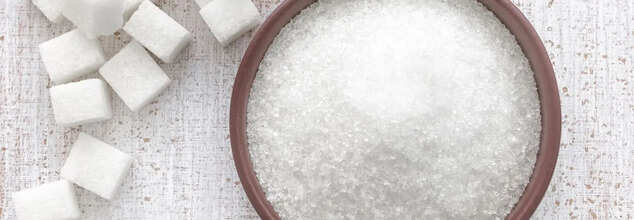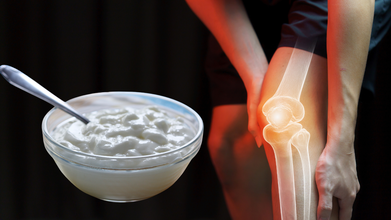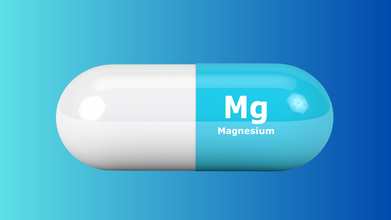- Health Conditions A-Z
- Health & Wellness
- Nutrition
- Fitness
- Health News
- Ayurveda
- Videos
- Medicine A-Z
- Parenting
- Web Stories
30-Day No Sugar Challenge For Weight Loss: Know Its Benefits

No Sugar (Credit: Canva)
Reducing added sugar is crucial for overall health, as excessive consumption is linked to an increased risk of type 2 diabetes, heart disease, and other health issues. One effective strategy is participating in a “30-day no sugar” challenge, where individuals cut out all added sugars for a month, focusing instead on whole, nutrient-dense foods.
How Does 30-Day No Sugar Challenge Works
During a 30-day no sugar challenge, participants eliminate added sugars found in products like breakfast cereals, ice cream, cookies, cakes, candy, soda, and sweetened coffee drinks. Natural sugars from fruits, vegetables, and dairy are allowed. This approach aims to reduce added sugar intake and improve overall health by shifting focus to healthier food choices.Health Benefits of Reducing Added Sugar
Blood Sugar Management: High added sugar intake can lead to insulin resistance and elevated blood sugar levels, increasing the risk of type 2 diabetes. Reducing sugar helps manage blood sugar and insulin levels, though long-term benefits depend on maintaining a low-sugar diet beyond the challenge.
Weight Loss: Foods high in added sugars are often calorie-dense and nutrient-poor, contributing to weight gain and obesity. Cutting out these foods can aid weight loss and reduce visceral fat, which is linked to heart disease.
Oral and Liver Health: Reducing added sugar can improve dental health by lowering the risk of cavities and protect the liver from conditions like nonalcoholic fatty liver disease (NAFLD). High sugar consumption is associated with increased liver fat and inflammation.
Heart Health: Excessive sugar intake is linked to high blood pressure, elevated triglycerides, and cholesterol levels, increasing heart disease risk. Limiting sugar can lower these risk factors and contribute to better heart health.
Additional Benefits: Reducing sugar may also improve mental health, skin health, and energy levels. Lower sugar diets are linked to decreased anxiety and depression, better skin, and sustained energy from nutrient-rich foods.
Is Yogurt as Good for Your Bones as It Is for Your Gut?

Credits: Canva
We have been often told that milk, and dairy products are great for our bone health, especially due to its high vitamin D and calcium components. This is also true for yogurt, but is there enough evidence to support this argument? A new study published in the journal Frontiers in Nutrition checks exactly take. It has taken a closer look at the question of eating yogurt to improve bone health. While the findings may show promise, the researchers say that evidence is not strong enough to call yogurt a bone-strengthening food on its own.
Why yogurt Is Believed To Be Bone Healthy?
yogurt is made through fermentation of milk, and it uses two specific bacterial strains, namely: Lactobacillus delbrueckii bulgaricus and Streptococcus thermophilus.
While yogurt and milk share similar nutrient profiles, yogurt offers additional benefits due to the above mentioned bacteria. They also produce vitamins and biologically active compound that could support overall health.
When we age, our bones lose mass and bone formation slows down, while resorption or bone breakdown speeds up. This also increases risk of fragility fractures. This is why nutrients like calcium, vitamin D, phosphorus, and potassium play vital role in maintaining strong bones. yogurt is also rich in protein, calcium, zinc, selenium, and vitamin B and K which is also recommended as bone-friendly food.
Some experts also believe that yogurt offers an edge over milk due to the higher levels of certain vitamins and minerals it provides. Furthermore, they claim that there is a better absorption of nutrients through yogurt. However, despite this theory, the studies have only shown mixed results.
How Was the Study On yogurt's Impact On Bone Health Conducted?
For the latest study, the researcher reviewed the existing evidence on yogurt's impact on bone health. The study analyzed data from scientific databases, including PubMed, Cochrane Library, and Scopus. These were published between 1970 to 2023.
The team had both the groups, namely: healthy adults and individuals with osteoporosis. The study included a comparison of yogurt intake to no yogurt, non-fermented dairy products, or standard osteoporosis treatments. Then, they evaluated observational studies and randomized controlled trials (RCTs), extracting data on participants’ demographics, yogurt dosage, study duration, and results.
In order to ensure accuracy, the study also assessed the quality of evidence using established methods such as the Newcastle-Ottawa scale and the GRADE system. Finally, they conducted meta-analyses to evaluate two major outcomes, hip fracture risk and femoral bone mineral density (BMD).
What Did The Study On Analyzing yogurt's Impact On Bone Health Find?
The study found that of the 1,302 studies reviewed, only 12 met the eligibility criteria that represented 14 observational studies. Most of them were conducted in the US, Europe, and Asia, and focused on postmenopausal women, a group that is particularly vulnerable to bone loss.
There were some studies that found a relation between higher yogurt consumption to better bone mineral density. On fact, one of them even reported that people who consumed yogurt more frequently had a lower risk of radius osteoporosis and higher hip and femoral neck BMD levels.
However, when researchers pooled the data, the overall effect was quite small. The meta-analysis showed that yogurt intake had a statistically positive but clinically negligible impact on bone density (SMD = 0.009) and no clear association with hip fracture risk.
The team also noted several limitations. Most studies didn’t specify the type of yogurt consumed, whether it was full-fat or low-fat, fortified or plain, or contained live bacterial cultures. Since all the data came from observational studies, it was also hard to prove a cause-and-effect link between yogurt and stronger bones.
Can Omega-3 Rich Diet Protect Women From Alzheimer’s? New Study Brings Hope

Credits: Canva
Women should make sure their diets include enough omega fatty acids, researchers say, after finding unusually low levels of these compounds in female Alzheimer’s patients.
This comes from an analysis of blood samples from both Alzheimer’s patients and healthy individuals, which showed that unsaturated fats, including those rich in omega fatty acids, were up to 20% lower in women living with the disease. So, could an omega-rich diet actually help reduce Alzheimer’s risk?
Can Omega-3 Rich Diet Protect Women From Alzheimer’s?
A major study has shown that women with Alzheimer’s have markedly lower levels of unsaturated lipids, including omega fatty acids, in their blood compared to cognitively healthy women. This points to a potential protective role for these fats in maintaining brain health.
Alzheimer’s tends to affect women more, particularly after 80, though the biological reasons are still not fully understood. To explore differences between men and women, researchers analyzed plasma samples from 841 participants in the AddNeuroMed cohort: 306 with Alzheimer’s, 165 with mild cognitive impairment, and 370 cognitively healthy controls. Using lipidomics, they studied 268 individual lipids per participant and examined how lipid composition varied by sex, while also exploring possible causal links through mediation analysis.
The findings revealed clear sex differences. Three lipid groups were linked to Alzheimer’s in women, but only one in men (p<0.05). In women with Alzheimer’s, lipids rich in highly unsaturated fatty acids, including omega fatty acids, were consistently lower, while saturated fats were higher (q<0.05). Importantly, the impact of unsaturated phospholipids on Alzheimer’s risk was independent of cholesterol, LDL, or apolipoprotein B, suggesting a direct biological effect. Men with Alzheimer’s did not show these lipid changes compared to healthy men.
These results highlight that lipid biology in Alzheimer’s is sex-specific, with women showing a clear loss of protective omega-rich fats. While this does not prove a cause-and-effect relationship, it suggests that omega-rich foods like oily fish or supplements could help reduce risk, though clinical trials are needed to confirm this.
How Does Omega Rich Diet Help With Alzheimer's?
A diet high in omega-3 fatty acids may support brain health and lower Alzheimer’s risk through anti-inflammatory, antioxidant, and neuroprotective effects. The most important omega-3s are docosahexaenoic acid (DHA) and eicosapentaenoic acid (EPA), which are essential for proper brain structure and function, according to Healthline.
Women And Alzheimers
About two-thirds of people with Alzheimer’s in the US are women, notes Harvard neuropsychologist Rachel Buckley, PhD. “Women actually tend to live with dementia longer than men.”
Women are more likely to develop Alzheimer’s due to a mix of biological, social, and cultural factors, including longer life expectancy, hormonal changes after menopause, and differences in education and work experience. The disease can also show up differently in women; some studies suggest tau protein spreads faster in their brains, which may delay diagnosis until later stages, according to Harvard Health.
Recent research has highlighted that the reasons for the sex gap in Alzheimer’s are complex, involving both biology and social factors. Potential contributors include women’s exposure to sex hormones, genes on the X chromosome, the presence of risk factors like hearing loss, the APOE4 genetic variant, and lower cognitive reserve related to education levels.
Why Magnesium Matters More Than You Think

Credits: Canva
Magnesium supplements are everywhere. Whether you see it on pharmacy shelves or wellness blogs and social media where influencers who swear by them. You’ve probably heard someone claim that a daily magnesium tablet can help you sleep better, ease muscle cramps, or boost your mood. But do you actually need one, or is this just another wellness trend gone too far?
What Is Magnesium and Why Do We Need It?
Magnesium is an essential mineral that plays a crucial role in over 300 biochemical reactions in the body. It helps regulate muscle and nerve function, supports a healthy immune system, builds protein, maintains blood sugar and blood pressure levels, and aids in energy production.
Because the body doesn’t produce magnesium on its own, it must come from external sources such as food or supplements. The recommended daily intake varies: 310–420 mg for adults and 30–410 mg for children, depending on age and sex.
The good news? A balanced diet can easily meet these requirements. Magnesium-rich foods include nuts and seeds, leafy green vegetables, legumes, seafood, whole grains, and meat. Even dark chocolate can help, 100 grams of dark chocolate contains around 146 mg of magnesium.
Who Is at Risk of Magnesium Deficiency?
Most people get enough magnesium from food, but certain groups are more vulnerable to deficiency. These include people with gastrointestinal disorders such as Crohn’s disease or coeliac disease, those with type 2 diabetes, people who consume excessive alcohol, and older adults.
If you’re low on magnesium, you might notice symptoms such as muscle twitches, spasms, fatigue, low appetite, nausea, or an irregular heartbeat. However, the only way to confirm a deficiency is through a blood test prescribed by your doctor, which, in most cases, is covered by Medicare.
Can Magnesium Supplements Really Help?
Magnesium supplements are often promoted as a solution for muscle cramps, migraines, and insomnia. But do they actually work?
While magnesium deficiency can lead to cramps, most cases of muscle cramps are not due to low magnesium. Research shows limited evidence that supplements prevent cramps, especially in older adults.
The link between magnesium and better sleep is also unclear. Some studies found it helped people fall asleep faster, while others found no significant difference.
When it comes to migraines, evidence is stronger. Studies suggest that taking 122–600 mg of magnesium daily for 4–24 weeks may reduce the frequency and severity of migraines in some people.
Are Magnesium Supplements Safe?
In general, magnesium supplements are safe when taken in the recommended amounts. However, too much can lead to nausea, abdominal cramps, and diarrhea, because magnesium draws water into the intestines.
Taking extremely large doses (around 5,000 mg daily) can cause magnesium toxicity, which is dangerous. Always check with your doctor before starting supplements, especially if you take other medications.
Different Forms and What to Watch Out For
Magnesium is available in tablets, powders, and even topical forms like creams and bath salts. While these skin-based products may raise magnesium levels slightly, they’re less effective than oral supplements or food sources.
When buying supplements, check the label carefully. Most tablets contain 150–350 mg of magnesium, but formulations vary widely. Some also include additional nutrients like vitamins B6, C, or D, and minerals like calcium or manganese.
Be cautious with vitamin B6, high intake can cause nerve damage over time. If you already take a multivitamin containing B6, avoid magnesium supplements that also include it.
© 2024 Bennett, Coleman & Company Limited

